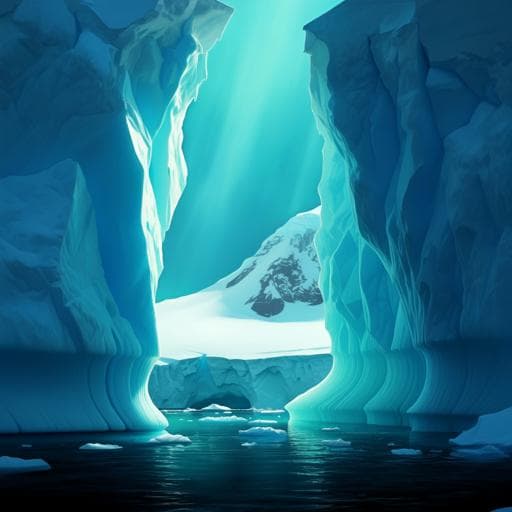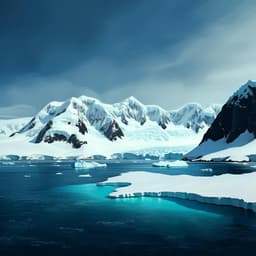
Earth Sciences
Ocean warming as a trigger for irreversible retreat of the Antarctic ice sheet
E. A. Hill, G. H. Gudmundsson, et al.
Warmer ocean conditions are set to greatly influence ice loss in Antarctica, revealing alarming shifts in ice shelf stability. This research conducted by Emily A. Hill, G. Hilmar Gudmundsson, and David M. Chandler highlights the dire consequences of a transitioning cold-to-warm ocean regime, resulting in rapid ice retreat and drastic environmental changes.
~3 min • Beginner • English
Introduction
The study investigates how an ocean thermal regime shift from cold to warm conditions beneath Antarctica’s largest ice shelves (Filchner–Ronne and Ross) affects upstream ice dynamics, grounding line stability, and mass loss. Recent decades have seen accelerated Antarctic ice mass loss, much of it in the Amundsen Sea Embayment where relatively warm deep water accesses sub-shelf cavities and drives high basal melt. By contrast, Filchner–Ronne and Ross currently sit over colder shelf waters but ocean modeling suggests near-future intrusions of warm deep water could occur on decadal timescales, increasing basal melt by an order of magnitude. The research question is whether such a regime shift could trigger substantial and potentially irreversible grounding line retreat and accelerate sea-level contributions from basins that are currently near mass balance. The study’s purpose is to quantify the ice sheet response and identify where and when retreat becomes irreversible, which is critical for anticipating sea-level rise risks.
Literature Review
Prior work has established that ice shelf thinning reduces buttressing and can accelerate inland grounded ice flow. Observed Antarctic mass loss has increased in recent decades, concentrated in the Amundsen Sea Embayment where warm circumpolar deep water accesses sub-shelf cavities. Multiple ocean modeling studies have projected regime shifts in the Filchner–Ronne and Ross cavities under future climate forcing, implying temperature increases of 2–4 °C and order-of-magnitude basal melt increases. Studies have also explored tipping behavior and potential for irreversible retreat in West Antarctica (e.g., Thwaites and Pine Island), including hysteresis and the possibility of collapse in deep marine basins. However, the direct quantification of ice sheet response to an immediate warm-state regime shift in currently cold cavities and the ensuing irreversibility thresholds has not been comprehensively assessed. This study builds on ensembles of ocean-derived melt fields (FESOM and NEMO) and integrates insights on grounding line stability to examine Antarctic-wide consequences in key basins.
Methodology
- Forcings: The study uses six perturbed ocean model-derived sub-shelf melt fields representing warm-state conditions from two independent ocean circulation models (NEMO4 and FESOM configurations) as 10-year means at the end of ~100-year idealized perturbation experiments. Reference states are also used. High-end scenarios produce cavity temperature increases of ~2–4 °C and large integrated melt increases, especially under Filchner–Ronne and Ross.
- Ice sheet model: The Úa shallow-shelf ice sheet model is initialized with BedMachine v2 geometry and observed velocities. A model inversion estimates parameters in a regularized Coulomb sliding law and Glen’s flow law. The mesh is refined near grounding lines (~2.1 km) and coarsens inland (up to 160 km). After inversion, a relaxation modifies surface mass balance by subtracting observed thickness change from RACMO, then forward simulations are run with adaptive mesh refinement. The calving front is fixed. Solid Earth feedbacks are excluded.
- Melt parameterizations: Three approaches propagate ocean melt forcing through time: (1) Mo: fixed ocean model melt rates applied at t0; newly afloat cells receive no melt; preserves spatial pattern but omits geometry-feedbacks. (2) Mmat: modern analogue technique mapping melt based on geometric similarity to training data points; updates with evolving geometry. (3) Mquad: quadratic dependence on thermal forcing; evolves with geometry. At initialization, parameterizations match integrated melts reasonably well; Mquad overestimates Ross under NEMO4.
- Experimental design: 40 forward experiments: 12 controls (four reference ocean states × three melt parameterizations) and 18 perturbed (six warm-state scenarios × three parameterizations) run for 100 years. Sub-shelf melt is imposed as Mref + Manom; Manom=0 in controls. Surface mass balance is held constant. Phases of accelerated grounding line retreat are identified.
- Reversibility tests: In high-end scenarios (NEMO4 and FESOMhigh) for Filchner–Ronne and Ross, perturbations are removed just before or at the onset of accelerated retreat, reverting to control melts or to 50% reduced control melts. Simulations continue up to 1,000 years to assess whether retreat halts, stabilizes, re-advances, or remains irreversible. Thwaites reversibility is also tested by halving control melts after 100 years in control runs to mimic cavity cooling.
- Ocean scenarios detail: NEMO4 warm-state represents late 23rd-century SSP5-8.5 high-end conditions (last 10 years of a 100-year perturbation). FESOM scenarios include high/mid/low states and a DIS high perturbation; some warm states induce a regime shift in Filchner–Ronne and, variably, in Ross. Reference runs are provided for all basins; Amundsen reference states under-resolve present-day melt, but NEMO4 captures CDW intrusions.
Key Findings
- Regime shift melt increases:
- Filchner–Ronne: Integrated melt increases from ~71–135 Gt/yr (reference) to 2,000–2,700 Gt/yr in high-end scenarios; ~1,200 Gt/yr in mid; ~340 Gt/yr in low. Melt is highest along the warm inflow path beneath Filchner.
- Ross: Reference ~58–148 Gt/yr; increases to ~2,500 Gt/yr (NEMO4 high) or ~1,300 Gt/yr (FESOMhigh). High melt concentrates along the front and western shelf. Quadratic parameterization overestimates Ross under NEMO4.
- Amundsen Sea Embayment (ASE): NEMO4 perturbed warms by +2 °C; integrated melt doubles to ~550 Gt/yr relative to observations (tripling vs. NEMO4 reference).
- Sea-level equivalent (SLE) changes over 100 years:
- Filchner–Ronne: High-end scenarios yield 64–97 mm SLE loss; control and low-end scenarios show −2.7 to 13 mm SLE. In high-end cases, grounding lines in the Robin subglacial basin retreat to a similar location ~160 km inland.
- Ross: Controls and low-end perturbations show mass gain (−4.42 ± 1.71 mm SLE). High-end scenarios switch to mass loss of 7–39 mm SLE. Grounding line sensitivity varies regionally, with Bindschadler showing concurrent volume loss as retreat proceeds.
- ASE: Continues losing ice at rates comparable to present day in most simulations: 32 ± 45 mm SLE after 100 years in controls. In perturbed NEMO4, SLE loss increases up to ~160 mm after 100 years.
- Grounding line dynamics and accelerations:
- Filchner–Ronne (Möller, Institute): Two phases of accelerated retreat; retreat limited in first ~20 years, then accelerates, often between ~6–34 km and ~34–150 km inland. Onset of rapid retreat depends on perturbation magnitude; low scenarios do not reach 34 km within 100 years. Retreat rate decreases near a topographic high at ~150–160 km.
- Ross (Bindschadler): After ~5 km inland, rapid retreat to ~36 km, a pause of 2–3 decades, then a second acceleration between 55–85 km inland.
- ASE (Thwaites): Acceleration once ~35 km inland (7–14 years). In perturbed NEMO4, final 100-year positions are ~120–130 km inland across parameterizations.
- Irreversibility tests:
- Filchner–Ronne (Möller): Reverting to control melts (or even 50% lower than control) after retreat reaches 6 or 34 km does not halt retreat across an overdeepened bed; retreat continues until ~110 km, then stabilizes at ~120–140 km for the remainder of 1,000-year runs.
- Ross (Bindschadler): After reverting to control melts at 5 km inland, retreat continues to ~45 km and persists for decades–centuries. Under NEMO4 control melts, re-advance near initial positions occurs after ~400–600 years. Under FESOMhigh, a second accelerated retreat leads to stabilization at ~85–91 km by 1,000 years. This suggests multiple quasi-stable states and potential regions of irreversible retreat.
- ASE (Thwaites): At present-day positions, grounding line retreat is not yet irreversible; halving control melts after 100 years halts further retreat when prior retreat was small (~6 km). However, if grounding lines reach ~60–100 km inland under control conditions, reducing melts by 50% does not prevent further retreat, which can proceed up to ~460 km inland within 1,000 years. Retreat likely becomes irreversible once ~75 km inland is crossed, consistent with earlier findings of possible collapse under current climate conditions.
- Combined impacts: After 100 years, SLE contributions from Filchner–Ronne and Ross under warm-state conditions could exceed those from the present-day ASE. Retreat in FR and Ross slows within ~100 years without further perturbation, and grounding lines can persist near retreated positions over subsequent centuries, implying no immediate runaway collapse via these catchments, in contrast to the deep marine basin inland of Thwaites.
Discussion
The results directly address whether a warm-state regime shift in sub-shelf cavities can trigger widespread and irreversible grounding line retreat in basins that are presently near mass balance. Applying high-end warm-state melts accelerates mass loss and initiates rapid, largely parameterization-insensitive retreat phases in key West Antarctic catchments. In Filchner–Ronne and Ross, identified thresholds lead to continued retreat even after restoring cold-state melts, highlighting hysteresis and committed change once certain inland positions are reached. This mechanistic linkage—ocean warming, sub-shelf melt intensification, loss of buttressing, upstream thinning, and crossing of bed-controlled thresholds—explains how thermal regime shifts can transform relatively quiescent basins into significant sea-level contributors.
The study shows that not all regions respond with runaway collapse: topographic highs and inland bed configurations in Filchner–Ronne and Ross tend to slow or arrest retreat at new quasi-stable positions, unlike Thwaites, where a deep marine basin can sustain continued inland retreat once thresholds are crossed. The robustness of accelerated and irreversible retreat across multiple ocean states and melt-geometry parameterizations strengthens confidence that a warm-state shift is a critical trigger. These findings underscore the importance of monitoring ocean conditions and sub-shelf access of warm deep water to anticipate rapid changes in sea-level contributions from currently cold-cavity basins.
Conclusion
A switch from cold to warm ocean conditions beneath the Filchner–Ronne and Ross ice shelves can rapidly convert these basins from near mass balance to substantial contributors to global sea-level rise within a century. High-end warm-state melt rates cause accelerated grounding line retreat and, in several locations, irreversible retreat that persists even if cold conditions are restored. While runaway collapse via these catchments is not immediate due to inland topography that slows retreat, the cumulative sea-level impact can exceed present-day losses from the Amundsen Sea Embayment under sustained warm-state forcing. The study delineates approximate thresholds and distances inland where retreat becomes committed, providing actionable targets for observation and modeling.
Future work should employ fully coupled ice–ocean models to refine timing and feedbacks, improve ocean resolution in small/warm cavities, integrate evolving surface mass balance and precipitation changes, incorporate calving processes and solid Earth feedbacks, and conduct detailed regional studies (e.g., Bindschadler) to resolve multiple quasi-stable states and tipping thresholds. Higher-resolution meshes and uncertainty quantification of basal sliding and rheology will further constrain centennial projections and irreversibility conditions.
Limitations
- Ocean model reference states under-resolve present-day melt in the Amundsen Sea due to coarse resolution and omission of subglacial discharge, affecting absolute melt magnitudes.
- The ice sheet model prescribes a fixed calving front and excludes iceberg calving processes, which could alter stress regimes near fronts but typically provide limited buttressing compared to interior shelf regions.
- Solid Earth feedbacks (e.g., viscoelastic bed uplift, sea-level feedback) are not included, potentially affecting longer-term retreat stabilization.
- Surface mass balance is held constant; expected precipitation increases in a warmer climate could delay but not prevent irreversible retreat once thresholds are crossed.
- Melt–geometry feedbacks are approximated via parameterizations; the quadratic scheme overestimates Ross melts under NEMO4; fully coupled ice–ocean simulations would better capture evolving feedbacks.
- Mesh resolution and treatment of melt near grounding lines influence transient retreat rates; while irreversibility findings are robust, precise timescales may vary.
- The timing of the regime shift itself is not simulated; warm-state melts are applied instantaneously as a step change, so real-world gradual transitions would spread the response over longer periods without altering irreversibility locations.
- Uncertainties remain in basal sliding laws and parameter values, though data-assimilated initialization helps constrain centennial-scale projections.
Related Publications
Explore these studies to deepen your understanding of the subject.







